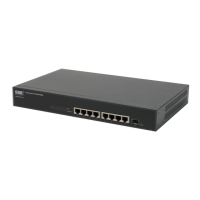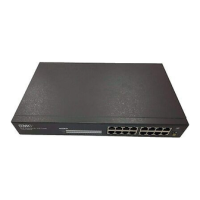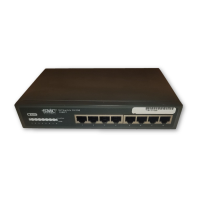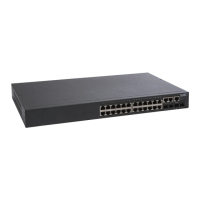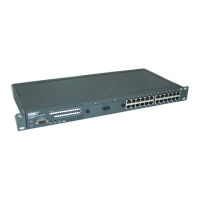Configuring the Switch
3-24
If the network has adequate performance and security for your current needs, it is
recommended that you leave the VLAN settings in the default configuration. The
default configuration is as follows:
• All ports are members of VLAN 1
• The switch management interface is on VLAN 1 (this cannot be changed)
• All ports have a Port VLAN ID (PVID) of 1
• All ports can send and receive both VLAN-tagged and untagged packets (that is,
they are hybrid ports)
In the default configuration, any port is able to send traffic to any other port and a PC
connected to any port will be able to access the management interface. Broadcast
traffic, for example, will be flooded to all ports on the switch.
There are three different parameters that can be configured for each port on the
switch; VLAN ID (VLAN membership), PVID and Packet Type. Note that the ports
within a trunk cannot be configured individually; configure the trunk instead (trunks
are labelled T1 to T4).
Field Attributes
• Port/Trunk – The port-number of the port or the ID of a trunk. This cannot be
changed.
• VLAN Awareness – VLAN aware ports will strip the VLAN tag from received
frames and insert the tag in transmitted frames (except PVID). VLAN unaware
ports will not strip the tag from received frames or insert the tag in transmitted
frames.
For QinQ operation, a customer port should be set to VLAN unaware and a
provider port (trunk port) should be set to VLAN aware.
• Packet Type – Sets the interface to accept all frame types, including tagged or
untagged frames, or only tagged frames. When set to receive all frame types, any
received frames that are untagged are assigned to the default VLAN. PCs should
be connected to ports with Packet Type set to “All.” PCs cannot, in general, send
or receive tagged packets. Switches should be connected to each other with
Packet Type set to “Tagged.” If the Packet Type is set to “All,” the port can accept
incoming tagged and untagged packets. Untagged packets will be associated with
the VLAN identified by the PVID. Tagged packets will be dropped unless the port
is a member of the VLAN identified by the VLAN tag in the packet. Outgoing
packets will be tagged unless the packet’s VLAN ID is the same as the PVID. If
the Packet Type is set to “Tagged,” the port will drop untagged packets and will
only send and receive tagged packets. Tagged packets will be dropped unless the
port is a member of the VLAN identified by the VLAN tag in the packet. The PVID
has no effect in this case.(Option: All, Tagged; Default: All)
• PVID –
VLAN ID assigned to untagged frames received on the interface. The PVID
(Port VLAN ID) is the VLAN ID that is associated with untagged, ingress packets.
It is not possible to remove a port from VLAN 1 unless its PVID has been changed
to something other than 1. The PVID has no effect on ports that have Packet Type
set to Tagged. (Default: 1)

